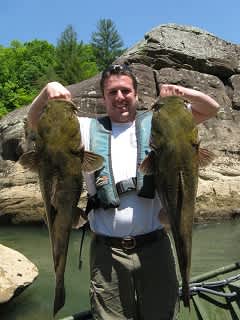It’s Catfish Time Across the State in Kentucky

When water temperatures warm into the 70s, it’s catfish time across Kentucky.
“Late May and June is the prime time for catching catfish from reservoirs, small lakes, rivers and farm ponds,” said Gerry Buynak, assistant director of fisheries at the Kentucky Department of Fish and Wildlife Resources. “The spawn is underway and with the onset of warmer weather, catfish settle into daily patterns. They begin to feed aggressively at dawn and dusk and throughout the night.”
The top three catfish species sought by anglers in Kentucky include the channel catfish, the blue catfish and the flathead catfish:
The channel catfish (Ictalurus punctatus) is the most widely distributed catfish species in Kentucky. It thrives in ponds and small lakes. It has a bluish-silver back, white belly and silvery sides with small, irregular dark spots. Adults are commonly 12 to 20 inches long.
“Each year almost 200,000 channel catfish are stocked in Kentucky waters,” said Buynak. “At the end of May, we’ll be putting channel catfish in 27 of our FINs (Fishing in Neighborhoods) lakes.”
To catch channel catfish, an angler must fish on the bottom. That’s because channel catfish are scavengers, using their super-sensitive whiskers to detect the odors of food on the bottom.
Use the basic slip sinker rig – a No. 2 hook, leader, barrel swivel and egg sinker – for bottom fishing. Night crawlers, shrimp, chicken liver or scented dough are excellent channel catfish baits.
The blue catfish (Ictalurus furcatus) thrives in big rivers such as the lower Ohio and Mississippi rivers, as well as their major tributaries. Blue catfish are also found in Lake Barkley and Kentucky Lake. In the last decade blue catfish have been successfully established in several small lakes and four major reservoirs — Taylorsville Lake, Barren River Lake, Dewey Lake and Fishtrap Lake.
The blue catfish is similar in appearance to the channel catfish. The most obvious difference is that the blue catfish has a straight anal fin. The blue catfish is bluish-gray with silvery sides and a white belly. The tail is deeply forked.
To target blue catfish in small lakes, use a bobber to keep the bait suspended about 6-8 feet below the surface. The best bait for blue catfish is cut bait, such as the viscera and gills of gizzard shad, chunks of bluegill, or pieces of minnow.
The flathead catfish (Pylodictis olivaris) is primarily found in large rivers and reservoirs.
It is brown to reddish-brown to yellowish with dark blotches on the top and sides, with a yellowish to white belly. It has a wide, flat head, a triangular-shaped tail and a protruding lower jaw.
Flatheads commonly reach 36 inches and can live for 20 years. Adults are solitary and inhabit deep, sluggish pools during the day. They move into rocky shallows at night, often locating around cover. They eat live fish such as creek chubs, shiners, shad and sunfish.
Anglers should use a slip sinker rig with a small foam float attached to the leader. Hook the baitfish through the tail to keep it from snagging on the bottom.
Catfish in Kentucky are big, abundant and found throughout the state. Now is time to start fishing for them.

